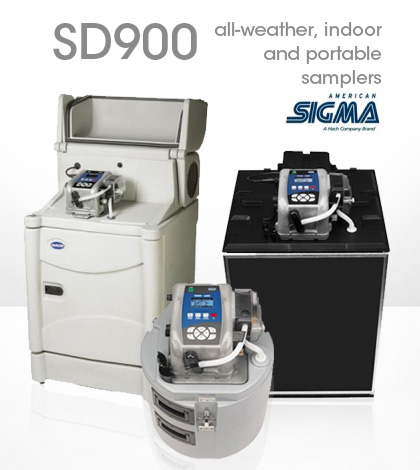Hach’s Sigma SD900 sampler line offers full range of options

Many variables affect water quality management needs. While one sampler can’t fulfill them all, Hach’s Sigma SD900 series gives users a full range of options, including portable, refrigerated and all-weather versions.
The popular line is used for pumping water samples out of streams, culverts or drinking water intakes to eliminate the need for manual sampling. Samples can be pumped into up to 24 separate bottles or one large jug. Sampling can be triggered based on the occurrence of certain events. Automated, scheduled sampling is also possible by using the controller on each sampler.
The SD900 Compact sampler is ideal for on-the-go applications. They’re commonly used in monitoring wastewater treatment collection systems and stormwater discharge. They can also be used in tracking the impact of human or animal activities on water quality.
“Many of these are in remote areas or sampling is only needed on a temporary basis,” said Jamie English, product manager.
The portable sampler can be set up in as few as two minutes and, like the other samplers in the series, has intuitive icons, large buttons for gloved hands and easy-to-follow menus.
“Scrolling menus allow users to view information such as program information and sample data without the need for a very large screen,” said English. “Samplers need to be as small and lightweight as possible, especially in portable applications.”
Where the portable sampler stands out with its easy setup, the refrigerated version helps users with advanced application needs.
The SD900 Indoor refrigerated sampler is commonly used in permanent monitoring applications, like at industrial plants or wastewater facilities. The All-Weather SD900 may also be used indoors, but is commonly used outdoors.
Depending on the external environment, all-weather samplers heat or cool themselves to preserve a sampling temperature of 4 degrees Celsius. They come with the pump compressor on top to avoid hydrogen sulfide and other corrosive gases and have chemically resistant coatings to protect refrigeration lines.
Considering the different sampler options, maintenance is fairly simple for the units. This makes sense, given that the pump tubing on each one has a lifespan of 20,000 cycles. The pumps themselves don’t need to be changed and desiccant packs need to be replaced periodically.
“Other samplers require disassembling the controller to change the desiccant and the pump tubing isn’t clearly visible from the outside of the unit,” said English. “And they require much more frequent tubing changes.”
Easy maintenance pairs well with the samplers’ accessorization. Solar panels can be used to power them and rain gauges can be used alongside to measure storm events. Water quality sensors may also be used in concert with the samplers to determine the quality of a wastewater stream.
“Sampling is high on the agenda for both water treatment specialists and for any industrial process that uses water,” said English.
She says increasing legislative pressures are forcing more companies to invest in onsite facilities for sampling, measuring and recording trade effluent. Other discharges from industrial and commercial processes have to be monitored for compliance with water regulations.
“Companies can also use the information to monitor plant efficiency,” said English. “In the past, manual grab sampling methods were used to extract samples for analysis.”





0 comments